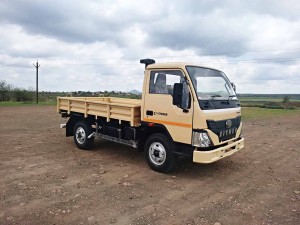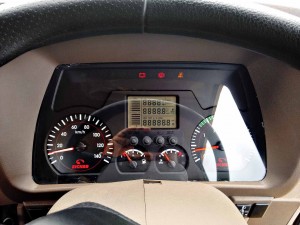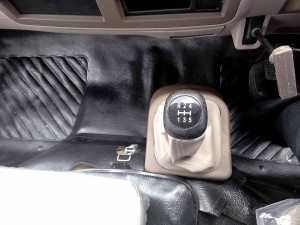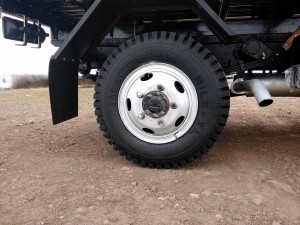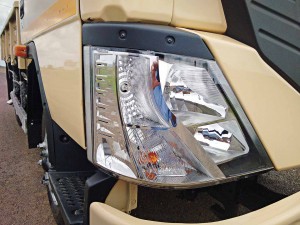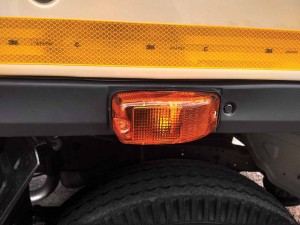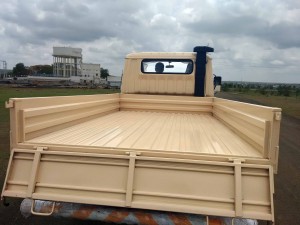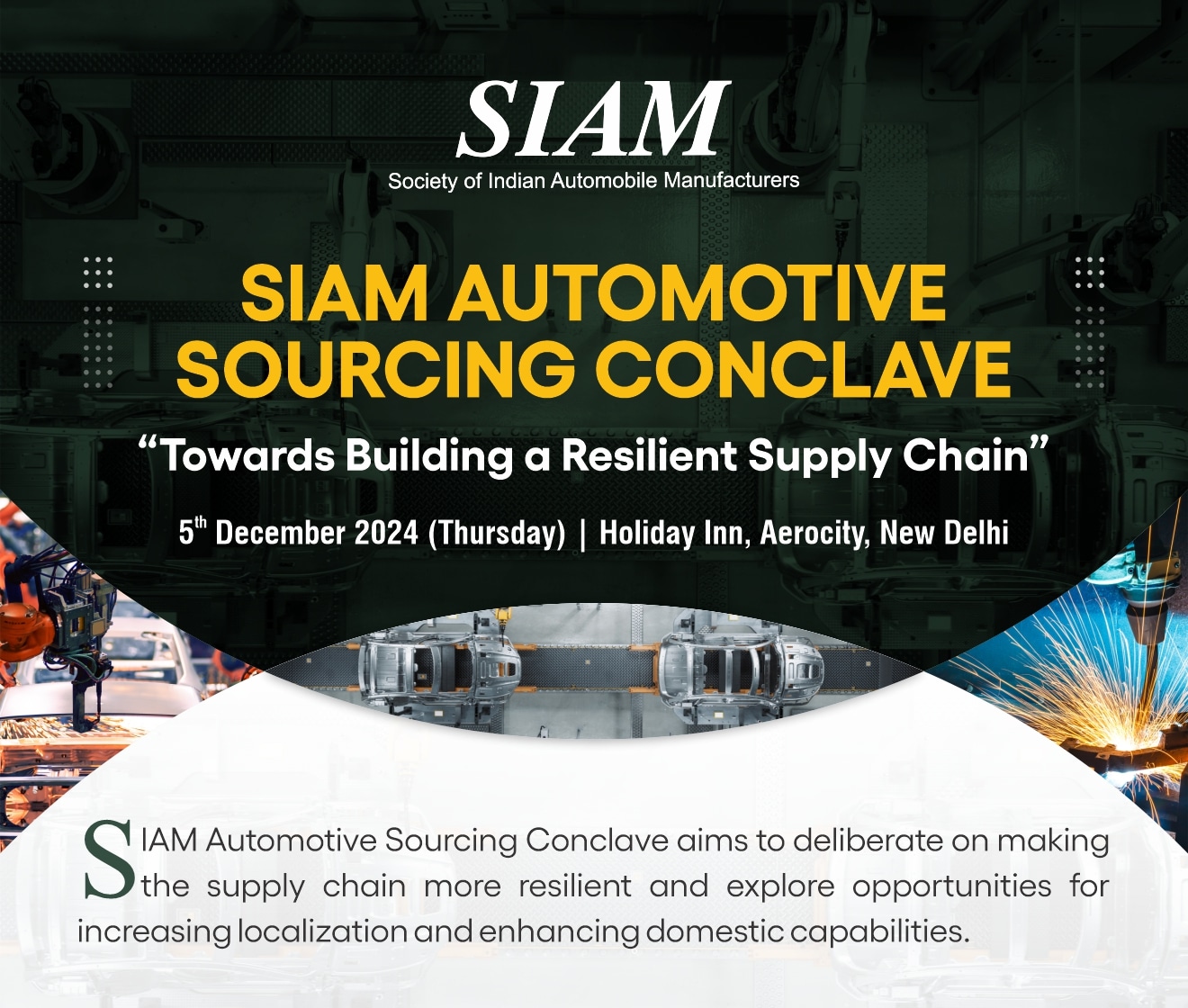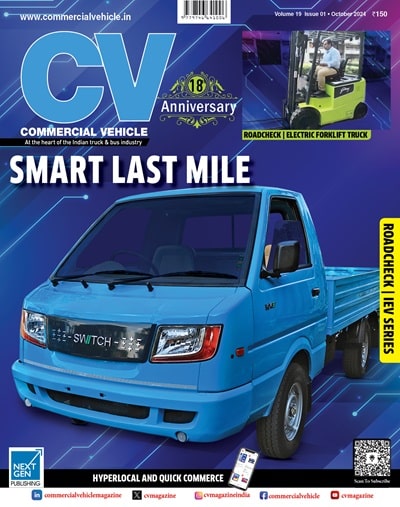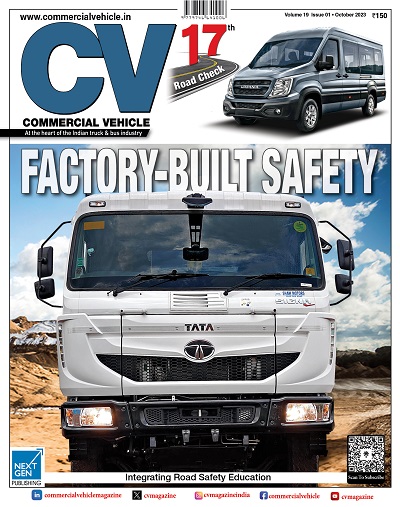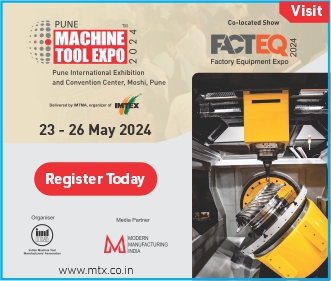The new Eicher Pro 1049 marks Volvo Eicher Commercial Vehicle’s entry into the sub-five tonne truck segment.
Story & photos by:
Bhushan Mhapralkar
The Eicher Pro 1049 is Volvo Eicher Commercial Vehicle’s (VECV) first sub-five tonne offering. Derived from the 1059XP, a 7.2-tonne GVW truck, the 1049 looks modern and attractive. It comes from a company whose trucks in the nine- to 16-tonne segments are known to have helped transporters to build their business. One look at the specifications of the 1049, and it is clear that this truck would compete against the likes of Tata 407 and Mahindra Cab King. Adding to the Pro 1000 Series, the 1049 is a forward control design. Flaunting good levels of fit and finish, the truck, offering a payload capacity of 2.8-tonne, has a GVW of 4.9-tonnes. Sharing the cabin with the 1059XP, it may be easy to mistake the 1049 for a 1059XP and vice versa. Those who are familiar with the 1059XP will agree that the cabin of the 1049 is spacious. Spacious it is indeed. It also hints at commonality of parts and the capability of suppliers. According to R S Sachdeva, Executive Vice President – Technology, VECV, “An ‘Indian-ised’ version of Volvo Group’s supplier development and procurement system called the ‘SIPD’ is deployed at VECV.” The system, said Sachdeva, not only makes for a free flow of know how at either end, it also ensures transparency that provides a supplier the much needed assurance to conduct business. Apart from streamlining the processes and supplier interaction, the SIPD also has an effect on the entire product lifecycle, which helps the dealer to attend to the service requirements of the truck operator. With an eye on the Euro 6 legislation, VECV has been investing in world-class testing facilities at its plant at Pithampur.
Considering the amount of work that is on to meet the Euro 6 emission regulations that are scheduled to be implemented by 2020, it did not come as a surprise when Sachdeva averred that the 1049 will be a platform for packaging technology. Technology that would involve packaging an entire chemical plant on the truck to meet Euro 6 regulations. No surprises there; dominating the front fascia of the 1049 is a composite winged pseudo-grille. It contributes to the Eicher business look of the truck. The attractive looking vertically structured clear lens headlamps also contribute to the business look. A neat looking bumper at the bottom and a large windshield at the top complete the equation. They add a touch of modernity to the truck’s appearance.
Smart and attractive
Marking the sides are doors that open lower down. They ensure easy access. The lowered door windows ensure good visibility. They help notice other road users that may be travelling besides the truck, especially when turning. The large mirrors are helpful too. Viewed from a three-fourth angle, the 1049 looks cute, almost toy-ish. It draws attention despite a sense of design familiarity. Expected to be more of an urban dweller, attention has been paid towards manoeuvrability. The 1049 may be wide to ensure good cabin space and loading area, it is short enough to support good manoeuvrability. A clue is the small rear overhang of the truck. Offered by a company that commands 35 per cent market share in the 5.9- to 14-tonne category, the 1049 promises superior fuel efficiency and loading capacity. Mentioned Sachdeva, “The 1049 offers 10 per cent higher fuel efficiency.” “In a market that accounts for 9000-1000 units per year, this truck has been engineered to address customer needs such as driving comfort, NVH, good looks, manoeuvrability, and an ability to offer maximum fuel efficiency and load carrying capacity,” he added. The loading tray of the 1049 measures 3068 mm in length, and 1850 mm in width. According to Sachdeva, the 1049 is aimed at 42 application areas. These include fruits and vegetables, FMCG, white goods, beverages, milk, parcel and courier, poultry, water bottles, ecommerce and domestic LPG cylinders.
Most suitable
Look beyond the modern appearance of the 1049 and its cute looks, a clear business proposition is visible. It may have taken VECV an amount of time to enter the sub-five tonne segment, it is however clear that a good amount of homework has gone into the development of the product. Stated Sachdeva, “We were busy expanding our reach in the heavy-duty and medium duty segments. The decision to enter the sub-five tonne segment was taken two years ago. It was found that the customer did not have a suitable offering in the segment. The 1049, apart from the most powerful engine in its class at 70 kW, also sports the widest cabin in its class.” From behind the two-spoke wheel, the view ahead is uninterrupted. The composite dashboard looks modern. Its hard to touch surface is built to last long. The large instrument console is made up of two large dials for speedo and tacho each. There are two small dials for fuel and temperature, and a LCD readout that indicates time and odo apart from a host of other information like the date of next service, etc. The two-point seat belt is a bit of a shock. The seat is comfortable even though it looks flat. The passenger seat is big enough to seat two people. Space, it is clear, is in good supply. Ergonomically well sorted, attention has also been paid to keep noise, vibration and harshness levels low.
Drive
Turn the key, and not much happens. The instruments do a diagnostic run and are ready to communicate. Another turn of the key wakes up the 95 hp, 3.3-litre, four-cylinder turbocharged inter-cooled diesel engine. Located under the seat, the engine is longitudinally placed with the drive routed to the rear wheels. Mechanically governed (electronically governed in BS IV model) according to Sachdeva, the engine belongs to the legacy range of engines that include a 3-litre engine, a 3.8-litre engine and a 5.2-litre engine. Slot into first – the five-speed transmission feels surprisingly easy to operate. Turn the steering to pull out of the parking slot. Good visibility makes it easy to drive out of tight spots. Despite being wide, the 1049 is easy to manoeuvre. The steering is light, and the truck responds well to inputs. Riding on 7.00 x 16 – 16PR tyres, the 1049 feels agile. The first ratio is engineered for torque. Progress in speed is achieved in the second and third gear. The clutch is light to operate, and the throw of the gears is not as long. Speeds in the region of 50-60 kmph are achieved with ease. A twisty mountain stretch on the outskirts of Pithampur did not pose any problem for the 1049 in terms of momentum. The vacuum assisted exhaust brake proved useful while descending the hill.
With power starting to roll in from lower down, the 1049 feels spritely. A good supply of power is felt as revs built past 1500 rpm. Rather than peak at a certain rpm, torque is spread over a portion of the rev range, and results in good drive-ability. The BS III version produces 285 Nm of peak torque at 1440 rpm. The (common-rail) BS IV version makes 300 Nm @ 1600-1800 rpm. Past the busy main thoroughfare of Pithampur, and on the Agra Bombay highway, the 1049 displayed its ability to gather speed. The maximum speed is claimed to be limited at 100 kmph. Noise inside the cabin is kept well under control even at good speeds. It is easy to converse even with the windows rolled down. At no point during the drive did the vibrations feel overwhelming. This would bode well for an operator who is also likely to use the truck as a personal transport beyond working hours. It is at this point, that it is easy to understand that the owner of such a truck is a daily wage earner, and operates in the urban jungle. He is also keen that his truck looks good, and is efficient as well as comfortable.
Ride comfort
The driving position of the 1049 is comfortable. The arrangement of the pedals, especially the brake pedal, takes some time to get used to. The braking action is progressive and inspires confidence. The brakes, hydraulic in nature, exert a strong bite. Even without load, the ride of the 1049 felt surprisingly pliant. The suspension is made up of semi-elliptic laminated leaf springs and shock absorbers. If there was anything that managed to ruffle the ride of the 1049, it were the crazy variety of speed breakers (speed humps) that dot the roads leading out of Pithampur, and into it.
Cost optimisation
Claimed to offer 10 per cent higher fuel efficiency over its competitors, the 1049 is a result of much cost optimisation. According to Sachdeva, each aspect of the truck, including interior noise, cabin comfort, manoeuvrability, power, turnaround time, fuel efficiency, etc., has been visited. Price too has been visited. The 1049 is competitively priced. “In the third month of introduction, we have received orders worth 500 units. Due to capacity constraint, we have been able to deliver 150-200 units only. Our projection is that this segment will go up from the current 10,000 numbers to 40,000 units in the next five-to-six years,” said Sachdeva. Having turned its attention to the sub-five tonne space, VECV is investing a good deal towards further development of new products and aggregates. The focus is on meeting the BS VI norms. It is at this level, that the challenge of packaging technology like EGR and SCR in a truck the size of 1049 is most severe, averred Sachdeva. By 2020, it may be safe to expect VECV to spring out a whole new generation of CVs, complete with new cabins, new engines, packaging (EGR and SCR), technologies (like AMT, hybrid and electric) and more. Sachdeva mentioned that the 1049 may be their first sub-five tonne offering, it is in no way their last. Apart from new variants of the 1049, Sachdeva also hinted at new products, new engines and more. In view of the changing equations at VECV, the Eicher Pro 1049, there’s no doubt, marks a smart move.
R S Sachdeva, Executive Vice President – Technology, Volvo Eicher Commercial Vehicles Ltd.
What went into the development and launch of the Eicher Pro 1049?
The Volvo Eicher range has been from 9-tonnes to 49-tonnes. In the LMD, we have a range of 5.9-tonne to 14-tonnes trucks. We have been very strong in this segment and have been commanding a market share of 30 to 35 per cent. Month after month we have been gaining the market share. We were contemplating upon entering the sub-5 tonne segment. This market is largely dominated by one or two players. Growth has been slow coming to this segment. It hovers in the region of 9000 to 10,000 units. The slow growth, we feel, has been because of the dearth of suitable products to address of the needs of buyers in this segment. Customers in this segment want driving comfort and good looks since they are mostly small fleet operators that are likely to operate in a city (in urban areas). They want the vehicle to be aesthetically pleasing; the cabin should be spacious and comfortable, and manoeuvrability should be good. The vehicle should deliver maximum fuel efficiency and load carrying capacity. We took an amount of time despite being certain of entering into this segment. We were busy pushing into the heavy-duty truck territory, and did not prioritise entry into the sub-5 tonne segment. We were also busy increasing our LMD market share at the higher end. Our focus towards the sub-5 tonne segment was drawn two years ago. We came to realise that the customer does not have a good offering. We then conceptualised and developed the 1049.
How would you define the 1049 against the current segment offerings?
Powering the 1049 is the most powerful engine in the segment at 70kW. The cabin is the widest in the segment. Available in BS III and BS IV versions, we concentrated on engineering a suitable driveline and drive comfort. The wheelbase of the truck is small but the width is more. This results in high level of manoeuvrability. With no compromise in the loading area, the 1049, in the benchmarking exercise that we carried out, was found to be over 10 per cent fuel efficient than the competitors. The load body has been so engineered that it can aid carriage of a certain number of LPG cylinders. The 1049 is aimed at gas cylinder transportation, vegetable transportation, and numerous other transportation applications. To ensure this, we optimised the width such that the truck can carry maximum number of crates or cylinders.
What kind of numbers do you expect the 1049 to deliver?
The challenge is that we do not have the capacity. We are operating at almost 110 or 120 per cent. Every month it is a struggle to meet the market demand. This is because the HD market has gone up by 30 per cent. The LMD market has gone up by 10 to 15 per cent. Our share in the bus market is also increasing. Our market share is actually growing in all the segments that we are present in. We are finding it difficult to produce enough 1049. We have introduced the 1049 in few markets. In the third month of introduction we have got an order of 500. We have however been able to supply 150-200 units. Customer reception is very good. In terms of interior noise, cabin comfort and manoeuvrability, power, fuel efficiency and turn around time, the 1049 is more apt. It is priced cost competitively. We are confident of expanding the market segment of 1049 from the current 10,000 numbers to 40,000 numbers in the next five to six years. The 1049 is our first offering in this segment, it is not the last.
What does the 1049 indicate about the segment future?
We are investing a good deal of money in the segment the 1049 is. In the next three to six years, at the Euro 6 level, the product offering will be completely new. There will be next generation cabin, next generation engine and packaging which would not just include conventional aggregates but also advanced ones like AMT, hybrid and electric. The sub-5 tonne segment, which was unattended by us until now, will get a lot of attention. The 1049 with a 4.9-tonne GVW offers a payload of 2.8-tonnes. Not very different from our current LMD range, the 1049 is our first sub-5 tonne offering.
With the 1049 launched, what are your plans?
For the future, we are working on a complete product range. These would include new engines. The plan will unfold as we proceed. Preparations are on to meet the Euro 6 emission regulations. In the sub-5 tonne range, there will be next generation cabs and engines. The Government and the judiciary are keen that we develop Euro 6 technology and vehicles. Euro 6 development is the most critical that we have done thus far. In this system, the emission comes down by 80 per cent. Euro 6 would mean the carriage of a complete chemical plant on a truck, including the EGR, EPF, SCR, and a controlled OBD system. The chemical plant on the truck would act as an air purifier. Exhaust on Euro 6 is going to be cleaner than the Delhi air.
How challenging would it be to package a chemical plant on a light truck like the 1049?
It is a key challenge in front of us. When one speaks about a smaller vehicle, the duty cycle is such that it calls for a cold EGR. This is a more complex technology. This poses packaging challenges since there’s the EGR system, the DPF system, and the DOC system that needs to be included. There’s also the SCR system, the ammonia slip sensor, the OBD system, urea injection system and the Adblue tank. It is tough to package all this on a smaller wheelbase truck. Associated issues like the lack of prescribed Adblue quality will mean the engine can go into limp mode as the amount of ammonia increases. The vehicle may come to a standstill.
Would the 1049 play a guinea pig for packaging new technologies?
The packaging success achieved on the 1049 will make it easy to package products up to 14-tonnes. The complex modularity will be much more in terms of packaging when it comes to smaller and lighter products. Once successful on a truck like the 1049 technology packaging can be carried forward to other products easily.
How many application areas are you looking at for the 1049?
We are looking at 42 applications in total. We will be progressively adding more application areas. We could also look at areas like refuse trucks, parcel van, and as a last mile connectivity solution for ecommerce players.
What is the buyer profile of the 1049?
The buyer of a 1049 would be a owner operator typically. He is likely to have migrated from an SCV to this vehicle. His aspirations are higher. He is looking for a vehicle that looks good; doubles up as his family transportation. He is a daily earner. Fuel efficiency and comfort are the key drivers for this segment. To keep the maintenance cost low, we have engineered the 1049 to have longer drain interval times. The drain intervals for the engine, transmission, axle, coolant and the steering gear are far longer than what the competition offers. Service frequency is half of that of the competition. A lot of technology has gone into the wear and tear parts like bushes. Their replacement cycle has been redefined.
Did you receive any inputs from the Volvo Group?
The styling of this cab has been done by Volvo like the other Pro series trucks, at the UD styling studio in Japan. The challenge was to keep the cost structure Indian and the appeal, mass market oriented. We get help from Volvo for validation. We are investing in our engine development facility by keeping in sight the Euro 6 emission regulations.
How has the Eicher legacy coupled with the Volvo philosophy to achieve success?
Out of the five engines we have, three are legacy engines and two are Volvo engines. They range between 3- and 8-litre, and power trucks ranging from sub-5 tonne 1049 to 49-tonne trucks that we offer. The legacy engines have been upgraded to BS III and BS IV emission norms with Volvo technology. All the five engines thus use Volvo ‘EMS’ (Engine Management System) system and Volvo cruise control technology. The fuel injection system is from Volvo, developed jointly with Denso of Japan. The engine control and operating system is Volvo derived. This was done because the engine’s ability to perform and be frugal. The other was to bring down the maintenance cost. There’s a common tech tool at the dealership that can be used to scan all the engines. It also helps with building competency.
How much commonality of parts did you invest in while developing the 1049?
There’s commonality in two key aggregates – cabin and engine. This would help us with cost competitiveness.
Are you expanding capacity since you are doing over 100 per cent?
We are increasing the capacity at the Pithampur plant. We are building a new HD line. We are investing at Pithampur because the economies of scale are much better. We have a well developed ecosystem with suppliers close by. The incremental costs are much lower. We have 150 acre land at Bhopal, and a plant over it. Consider this: Our historical high has been 48,000 vehicles so far. This year we will do more than 60,000 vehicles. We have produced over 16,000 trucks in the first three months of the this fiscal already. We are looking at 28 to 30 per cent growth this year. We are confident that we can carry out an incremental increase in capacity of 90,000 units before shifting to Bhopal.
As part of the Volvo Group how do you look at the future of Eicher as a brand?
The future, I think, is bright. This is one of the best JVs in the Volvo Group. Whatever technology we have absorbed from Volvo has been at an Indian cost. We continue to increase our market share in each segment. We are offering superior products with latest technology at mass market prices. We have been successful in localising technologies in India. If the 5- and 8-litre engines made at the Volvo Eicher Powertrain Technology plant were sourced from Japan they would have worked out to be much costlier. Post complete localisation and development, the cost of the engines is on par with the engines the competition offers. These engines have also been absorbed by many Volvo entities around the world, including Volvo Penta. They go to Thailand for the Quester range. In the next few years, you will see the two engines made here powering many new vehicles in different markets.
What role have the suppliers come to play in technology absorption and ‘Indianisation’?
Our dealing with the suppliers is on fair grounds. We focus on long-term relationships. We ensure good communication with the suppliers. Every month we convey to suppliers what we sold last month, and what is our next three months plan. We may falter on some of our plans by 5 to 7 per cent. The information however helps the suppliers to gear up for the future. The information also helps him to ascertain how the industry is progressing. Supplier relations at Eicher assume high priority, and are a part of Eicher’s DNA. In case of a crisis (the Chennai crisis for example; the 2011 crisis that saw suppliers like Bosch, Axle India, Brakes India and Meritor India ration their supply due to enormous shortage), we have observed that irrespective of the numbers we do we are given high priority. Our relation with the suppliers is devoid of any fear. Every year we conduct a supplier conference at Indore. Over 800 suppliers attend this conference. Much communication takes place. We get an opportunity to tell suppliers of our plans and what we would expect from them. We, at VECV, have been sourcing parts from our suppliers for export to Volvo entities. Engine parts particularly, that go into Euro 6 engines.
How does supplier relation help engineer new platforms like the 1049?
Suppliers have a definitive involvement in product engineering. In the Volvo Group, SIPD (Supplier Development Involvement Development) is particularly strong. This is especially the case in terms of technology. SIPD is about upfront involvement of the supplier. We have mapped and introduced SIPD at VECV. Under SIPD, we have got a completely new product development process. The key critical requirement of this process is that technology development has to happen prior to product development. Consider technology development of Euro 6 for example. It involves DPF or high efficiency SCR development. This technology, as per the process, should be developed independent of, and prior to the development of the product. Such a development is tough to perceive without supplier involvement. SIPD has to start right at the concept stage of the product. Supplier should be called at the concept gate itself; he should be told about the company’s aspiration and vision, and the inputs of the suppliers should be taken. Some of the module suppliers can directly develop. Some eight to 10 suppliers we have started to involve in the SIPD process. For example, IAC, which does cab interior parts development. There’s Bosch, Brakes India, Meritor, etc. They come and understand the concept, and what we are trying to do. They then commit their modules with our vehicle integration team. They also participate in the validation and DVP programs.
Does it somewhere indicate that suppliers are turning innovators?
We are benefited by the innovations of our suppliers. For their module they are the best brains. Many times we have found out that they have a better idea about their module. When it comes to the product overall, we may have a better idea. When it comes to their module, they have a better idea. Consider a turbocharger for example. To expect a turbocharger to extract better fuel efficiency, it is the turbocharger supplier who has a better idea. We respect that. Many times it gets difficult to crack an equation pertaining to achieving better fuel efficiency. Involving the suppliers helps. It is quite likely that a supplier will come out with an idea that we have not thought of. Such instances have happened with Cummins Turbo Technologies, with BorgWarner, and with many other suppliers. We ‘Indianised’ Volvo SIPD since in Europe a supplier is expected to stand on his own. In India, the competency levels are not so high unless the OEM works and develops that supplier. That calls for a slightly different approach under SIPD. In Europe, the supplier accountability aspect is very high. In India, past the big suppliers, there may be a need to hand hold the suppliers and mentor them.
Considering the supplier relations and ways of working, how modular is the 1049?
The 1049 is highly modular. It reflects our ambition to evaluate the complete area below five-tonnes. Modularity helps us to reduce the number and variety of parts, and to better organise the parts. It also helps at the store level, and at the aftermarket level.



